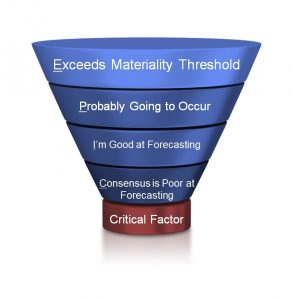Lacking Unique Stock Insights? Find and Focus Only on Critical Factors (Part 2 of 3)

In Part 1 of this 3-part series, I asked if you find your days jammed with meetings and calls and yet no killer insights. To solve this dilemma, I introduced a relatively simple concept that I’ve taught hundreds of highly-successful buy-side and sell-side equity research analysts, specifically to identify and monitor a stock’s critical factors.
If you follow this framework you’ll have more time for generating unique insights, model your companies better, be a better stock picker and communicate your stock calls more effectively. In this installment I’ll focus on separating critical factors from all the noise.
So how do we identify which of the hundreds of pieces of information that bombard us each day are truly “critical” to stock picking? Use our EPIC™ model below.
The EPIC™ framework asks four simple questions to keep you focused on those factors where you can generate the most alpha
- Exceeds my materiality threshold? First you need to define your materiality threshold. This is most easily defined as the amount that the consensus estimate would need to change for you (or your portfolio manager or clients) to take notice. Like any filter, you want it to be high enough so that you’re not including everything that comes across the news feed, but not so restrictive that your portfolio manager or clients complain you’re not aware of issues driving your stocks. Generally I find most analysts have a threshold that falls between 5% and 15%. (Try to have a number in your head rather than a range.) If the factor cannot cause consensus estimates to move more than your threshold, remove it from the critical factor list and don’t spend time on it! This is important. Don’t even let OTHER people bother you with this (including WSJ, Bloomberg, CNBC, etc.), with calls, meetings, reports or presentations. Tell them kindly it’s not likely to be material and you would prefer to spend time on other factors more likely to move the stock.
At one point, Starbucks requested customers leave their firearms at home which created a media firestorm, but hopefully no equity research analyst spent more than 10 seconds on it because it’s not going to result in consensus estimates changing beyond any analyst’s materiality threshold. (The financial media focused on it.)
- Probably going to occur during my time horizon? For this element, quantify your time horizon. I find most analysts use a number between 6 and 12 months, although there are short-term traders that prefer to close out trades every week, while some long-only funds have a minimum of a 3-year horizon. If the factor isn’t likely to occur during your time horizon, ignore it. Companies often introduce new products or enter new geographic territories with substantial fanfare, only for analysts to discover a year later that it had no material impact on earnings because it was slow to start. For example, is AAPL’s new watch (to be released next year) likely to cause consensus EPS to move unexpectedly beyond a typical investor’s materiality threshold (item #1 above) in the next 6-12 months? Probably not, and yet many analysts are dedicating valuable time to the watch. Instead, the best stock pickers gave it a cursory look and then shifted focus to the true critical factors likely to occur during their investment time horizon.
- I’m good at forecasting factor and catalyst? If you can’t forecast a factor better than consensus, even with additional research, then you shouldn’t be dedicating time to it. After all, alpha is generated by forecasting (or knowing) something that’s not in the market. Recommending a stock based primarily on an “improving economic climate” or a forecast that estimates oil or grain prices are going to move beyond the consensus range is likely to be questioned because how are you any better at forecasting these factors than the market? (If you’re really good at this, you should hang up your analyst job and be running your own fund.)
- Consensus is poor at forecasting or spotting factor? If the factor is routinely being forecast accurately by most of the key participants in the financial markets you probably aren’t going to develop a unique insight to exploit with a stock call. So don’t spend time on it.
Answers to these 4 questions will determine how much time you should spend researching any given issue. This link will allow you to open an Excel spreadsheet that summarizes the process and use it with your stocks. Let me know if it helps and how I can make improvements.
In my next Best Practices Bulletin™, I’ll return with Part 3 where I discuss the process to identify critical factors for an individual stock or sector. (AnalystSolutions provides equity research training with a specialized workshop to help Identify & Monitor a Stock’s Critical Factors.)
This Best Practices Bulletin™ covers the following elements of our GAMMA PI™ framework:
#1. Generate Informed Insights
#2. Accurately Forecast
#3. Make Accurate Stock Recommendations
#4. Motivate Others to Act
Visit our Resource Center to find more helpful articles, reference cards, and advice towards your growth as an Equity Research Analyst.
©AnalystSolutions LLP All rights reserved. James J. Valentine, CFA is author of Best Practices for Equity Research Analysts, founder of AnalystSolutions and was a top-ranked equity research analyst for ten consecutive years